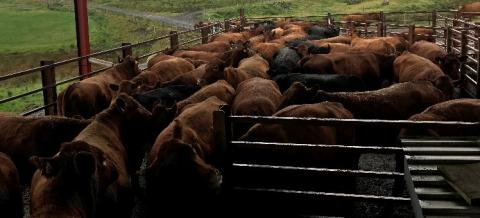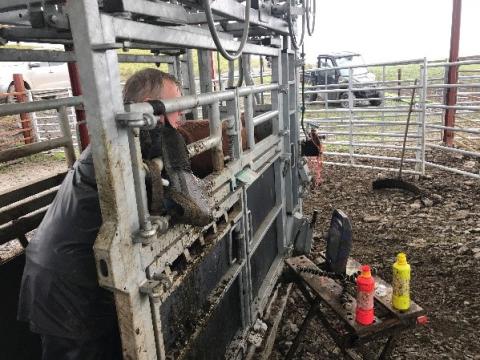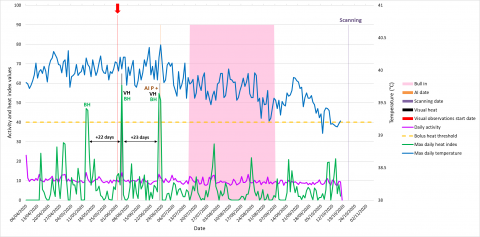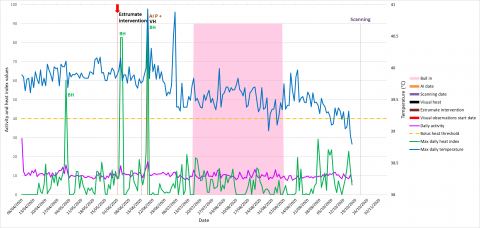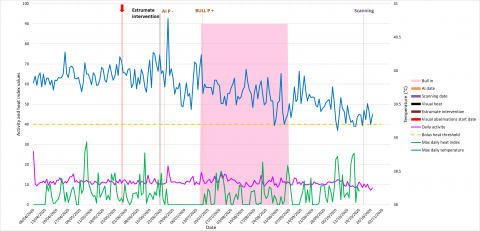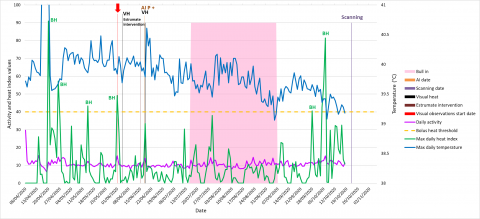Moelogan Fawr project update: Using technology to increase health monitoring – improving calving pattern, conception rates and reducing calving losses
Project aims
- To reduce the calving period via the use of innovative technology and increasing data collection
- Reducing labour inputs by using technology to aid heat detection
- Reduce the cost of veterinary fertility and health treatments
Project developments
A total of 39 smaXtec classic rumen boluses were administrated to yearling Stabiliser heifers at Moelogan Fawr in 2020. The purpose of the bolus is to continuously measure the animal’s activity and inner body temperature which can give an insight into the animal’s health status, as well as detect changes and send alerts at calving and oestrus. One of the key elements for this project was to identify each heifer’s insemination window by using the peak activity data, in order to carry out AI in-house at the most appropriate time within the cycle.
The boluses were administrated on 14 April 2020, with the monitoring period for heat detection commencing on 1 June 2020. The vet, Dr Iwan Parry visited the farm mid-June to carry out a blind veterinary assessment to determine each heifer’s stage in the cycle, as well as their reproductive maturity score and pelvic measurements. Pregnancy scanning was carried out on 22 October 2020, followed by detailed analysis of the data gathered throughout the monitored period.
Results to-date
The results have been summarised into key strengths and gaps identified below.
Key strengths
Figure 1. The key strengths identified in the results. Each graph indicates the data collected during the monitored period for an individual heifer.
Key weaknesses/gaps
Figure 2. The key weaknesses/gaps identified in the results. Each graph indicates the data collected during the monitored period for an individual heifer.
The first service AI pregnancy rates achieved has increased by >10% following bolus administration. This has resulted in achieving one of the project’s Key Performance Indicators set at the outset, which was to increase the percentage of heifers that stand in the first serve from 57% to >65%. In addition to this, the number of semen straws used has decreased by 4% in 2020 compared with 2019 figures.
Time spent on daily observation labour of the heifers was unchanged from previous years at five hours a day. Table 1 summarises the veterinary costs associated with impregnating the heifers prior to bolus administration, as well as post bolus administration. To note, the cost of the maturity scoring and pelvic measurements is not included as this was an additional assessment carried out as part of the project.
Table 1. Veterinary treatment costs associated with impregnating the heifers prior and post bolus application (CIDR (Controlled Internal Drug Release)) system for heat synchronisation used in 2018 and 2019; boluses administrated in 2020).
|
|
2018 |
2019 |
2020 |
|
Vet cost (£/heifer) |
£33.73 |
£29.51 |
£6.46 |
|
Financial saving from previous year (£/heifer) |
N/A |
-£4.22 |
-£23.05 |
In terms of additional costs, there was significant investment made at the beginning of the project for purchasing the boluses. This annual cost spread over four years is equivalent to <£32/heifer*. This includes the provision of further data for the detection of health problems and calving.
Next steps
As previously mentioned, Llion and Siân will receive direct alerts from the bolus via the smaXtec software prior to calving. The alerts will be generated based on changes in body temperature and should be of assistance before, during and after calving. The data will be evaluated along with visual observations at calving and heifer pelvic measurements to identify whether a correlation exists between the factors.
*Please note this value is based on the cost at project start and will vary from herd to herd, depending on several factors.

